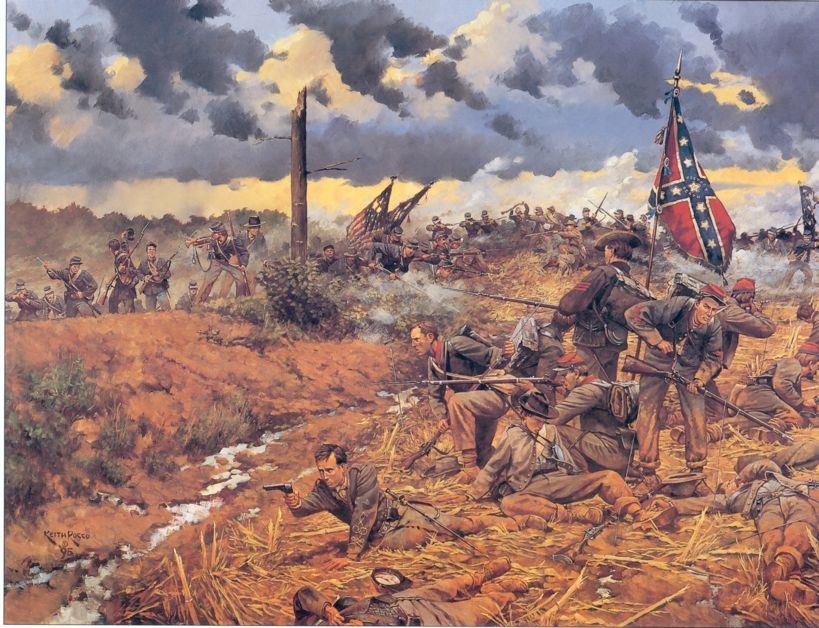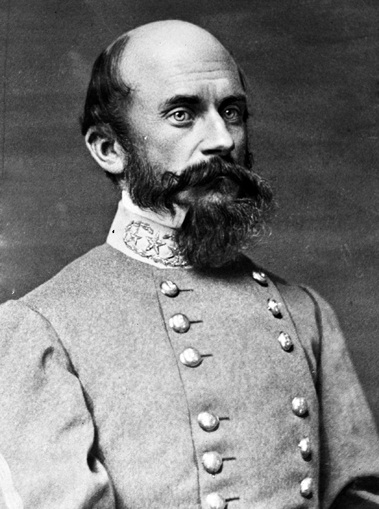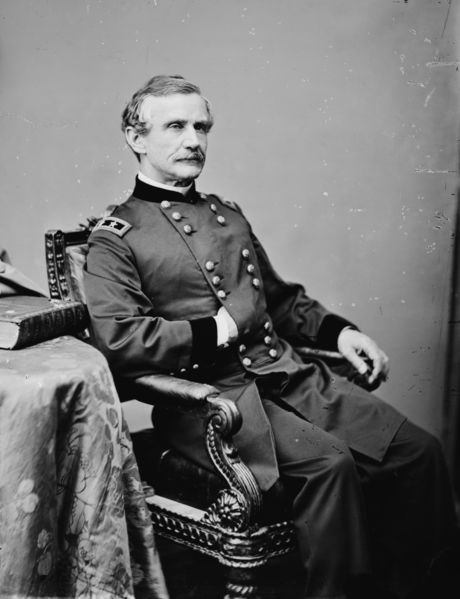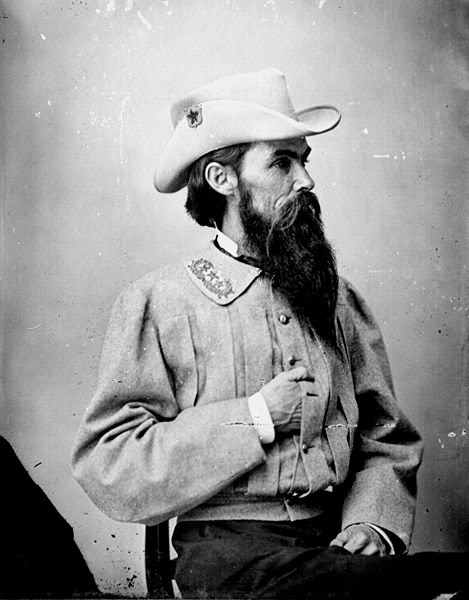|
The Federals then regrouped and returned to their job on hand and once again charged General Ewell's battle line. However, this time it resulted in the Union troops overwhelming the Confederates on both flanks. General Ewell would later recall, “On riding past my left I came suddenly upon a strong line of the enemy's skirmishers advancing upon my left rear. This closed the only avenue of escape, as shells and even bullets were crossing each other from front and rear over my troops, and my right was completely enveloped.”
Seeing no way out, General Ewell surrendered himself and his staff to a Union cavalry officer. The General forwarded a note to General G.W. Custis Lee, informing Lee of the surrender. He also allowed that he was cut off and suggested, that to prevent further loss of life, General G.W. Custis Lee should also surrender. In all, the Federal attack had bagged six Confederate generals and more than 3,000 men.
 "Victory or Death"Painting by Keith Rocco "Victory or Death"Painting by Keith Rocco
|
All but 52 of the remaining men of the 18th Georgia Regiment of Volunteer Infantry, were captured during this action. Only three days later, at Appomattox Courthouse, these 52 fighting men of Georgia including one officer, would be part of the surrender of the tattered and still faithful Army of Northern Virginia.
| |
 General Richard S. Ewell General Richard S. Ewell |
The battle was still continuing south of General Ewell’s troops, as Union cavalry under General Merrit began their mounted attack against General Anderson's besieged troops. The Confederates were behind their defenses made of rails, but were not safe from the Union cavalry’s repeating rifles and overwhelming numbers. As the enemy cavalry closed on the rebels, they opened a scathing volley then closed on the Confederate troops. Horrific hand-to-hand combat followed and men were clubbed, stabbed, sliced by swords, cut by knives and shot dead with pistol fire at close range. Soon, more Union troopers had joined the fray and collectively overcome the Southerners' stubborn resistance. Here, they captured two more generals, but many of General Anderson's men managed to escape through the woods and headed west toward Rice's Depot. It was at about this time that General Robert E Lee had ridden to a place he could observe the battle and after seeing the fleeing Confederate troops, sadly announced 'My God! Has the army been dissolved?'
Meanwhile, approximately two miles north of the positions of Generals Ewell and Anderson, the battle continued at Lockett's farm. General Gordon’s troops had followed the fleeing wagon train and had become bogged down near the bridges where the Big and Little Sailor’s Creeks came together. Here, General Gordon was forced to defend the wagons and try to protect the valuable munitions and rations they carried. The Confederates prepared for the
onrushing Union soldiers, as they dug in around Lockett’s farm. The soldiers did not have long to wait, as the Federal troops of General Humphrey’s II Corps began their attack around dusk. |
|
As the battle continued, the Confederates were forced to fall back towards the creek. They tried to use the wagons as barricades, but this position soon became untenable. The fight became very intense and desperate, forcing the Rebels to continue to withdraw and begin to flee up the opposite bank of the creek.
The men of General Humphrey’s II Corp were now in possession of more than 200 wagons and 1,700 prisoners, as the fighting ended. The Confederate troops who were able to escape, continued their retreat along the road that brought them to the High Bridge. Here they crossed the Appomattox River and joined up with soldiers who had escaped capture from the other fights along Sailor’s Creek and were placed under the command of Major General William Mahone.
General Lee and his staff, continued along the road toward the town behind the troops of General Longstreet combined corps and that of General Fitzhugh Lee’s cavalry. Once there, the Confederates found trainloads of supplies which included a 80,000 rations of meat and 40,000 rations of bread.
|
|  General Andrew A Humphreys General Andrew A Humphreys
|
|
When the tired and famished soldiers began to prepare their long awaited meals, the Union cavalry, which had been following their movements, arrived just east of town and began harassing the pickets. Sounds of rifle firing prompted the Confederates to close the train boxcars and send the train down the line to protect their supplies. Again, the Army of Northern Virginia, what little there was left of it, continued its withdrawal.
General Lee felt if he could get his Army to the north side of the Appomattox River, he could then have the double bridges (the High Bridge and the accompanying wagon bridge that ran alongside) burned to prevent the Union forces from giving chase and he may be able to open the distance between them.
By early afternoon, as the Confederates left Farmville, the Federal cavalry under General Crook began to enter the town and take it over. As this happened, General Lee’s troops made good their escape across the bridges and began the burning of the High Bridge, but the Union cavalry captured the wagon bridge pretty much intact.
The Union II Corps then crossed over the bridge and continued its pursuit against the fleeing Rebels. In order to protect the rear of the Confederate army, General Mahone's troops took positions on the high ground around Cumberland Church, which was five miles northwest of High Bridge and four miles north of the town of Farmville. Here they dug in and prepared to cover the retreat of the Confederate column. |
 General William Mahone General William Mahone |
Just after General Mahone’s troops got into their piecemeal defensive positions, lead elements of General Humphreys' II corps came in contact with the Confederate soldiers. The Union skirmishers were able to quickly overwhelm a few Confederate positions, capturing Rebel cannons as they moved. However, the determined Confederate infantrymen quickly rebounded and recaptured them. Seeing this, General Humphreys sought a way to bring his full force to bear and out maneuver the desperate Confederates.
In conjunction with this maneuvering, Union Brig. Gen. Nelson Miles moved his troops forward and to the right in an attempt to turn the exposed Confederate flank. One of his brigades was successful in getting behind the Confederate’s flank and threatened to overwhelm them. However, General Mahone quickly ordered up reinforcements, which in time was able to scatter the Union troops. As nightfall came over the battlefield, the fighting came to an end.
The majority of General Grant’s Federal troops were now in Farmville and had not managed to make it over the bridge to follow up the fighting of the day. So, seeing a respite in the pursuit, General Lee took the opportunity to again ask his now badly torn and greatly reduced Army of Northern Virginia to once again undertake a night march. They moved towards New Store, Appomattox Court House and then on to Appomattox Station.
Soon thereafter, General Lee received the first of several communications directly from his nemesis, General Grant. In it, General Grant brought up the possibility of surrender for the Confederate army.
|
|
"Gen. R.E. Lee, Commanding C.S.A.:
5 P.M., April 7th, 1865
The results of the last week must convince you of the hopelessness of further resistance on the part of the Army of Northern Virginia in this struggle. I feel that it is so, and regard it as my duty to shift from myself the responsibility of any further effusion of blood by asking of you the surrender of that portion of the Confederate States Army, known as the Army of Northern Virginia.
U.S. Grant, Lieutenant-General" |
|
Looking it over, Lee handed it to General Longstreet, who read it and replied, 'Not yet.'
General Lee then drafted a response that read:
|
"April 7th, 1865.
General: I have received your note of this date. Though not entertaining the opinion you express of the hopelessness of further resistance on the part of the Army of Northern Virginia, I reciprocate your desire to avoid useless effusion of blood, and therefore, before considering your proposition, ask the terms you will offer on condition of its surrender.
R.E. Lee, General." |
|
General Grant received the reply from General Lee, just after midnight, April 8th, 1865. An answer was drafted and again sent through the lines, to General Lee:
|
April 8th, 1865.
General R.E. Lee, Commanding C.S.A.:
Your note of last evening in reply to mine of the same date, asking the conditions on which I will accept the surrender of the Army of Northern Virginia, is just received. In reply I would say that, peace being my great desire, there is but one condition I would insist upon,--namely, that the men and officers surrendered shall be disqualified for taking up arms against the Government of the United States until properly exchanged. I will meet you, or will designate officers to meet any officers you may name for the same purpose, at any point agreeable to you, for the purpose of arranging definitely the terms upon which the surrender of the Army of Northern Virginia will be received.
U.S. Grant, Lieutenant-General" |
As the Army of Northern Virginia continued its march, General Lee sent another message to the Union Commander:
|
"April 8th, 1865.
General: I received at a late hour your note of to-day. In mine of yesterday I did not intend to propose the surrender of the Army of Northern Virginia, but to ask the terms of your proposition. To be frank, I do not think the emergency has arisen to call for the surrender of this army, but, as the restoration of peace should be the sole object of all, I desired to know whether your proposals would lead to that end. I cannot, therefore, meet you with a view to surrender the Army of Northern Virginia; but as far as your proposal may affect the Confederate States forces under my command, and tend to the restoration of peace, I should be pleased to meet you at 10 A.M. to-morrow on the old state road to Richmond, between the picket-lines of the two armies.
R.E. Lee, General." |
Exhausted from stress and suffering the pain from a severe headache, Grant replied to Lee around 5 o'clock in the morning of April 9.
|
"April 9th, 1865.
General: Your note of yesterday is received. I have not authority to treat on the subject of peace. The meeting proposed for 10 A.M. to-day could lead to no good. I will state, however, that I am equally desirous for peace with yourself, and the whole North entertains the same feeling. The terms upon which peace can be had are well understood. By the South laying down their arms, they would hasten that most desirable event, save thousands of human lives, and hundreds of millions of property not yet destroyed. Seriously hoping that all our difficulties may be settled without the loss of another life, I subscribe myself, etc.,
U.S. Grant, Lieutenant-General" |
Still suffering his headache, General Grant approached the crossroads of Appomattox Court House where he was over taken by a messenger carrying Lee's reply.
|
"April 9th, 1865.
General: I received your note of this morning on the picket-line, whither I had come to meet you and ascertain definitely what terms were embraced in your proposal of yesterday with reference to the surrender of this army. I now ask an interview, in accordance with the offer contained in your letter of yesterday, for that purpose.
R.E. Lee, General." |
General Grant immediately dismounted, sat by the road and wrote the following reply to Lee.
|
"April 9th, 1865.
General R. E. Lee Commanding C. S. Army:
Your note of this date is but this moment (11:50 A.M.) received, in consequence of my having passed from the Richmond and Lynchburg road to the Farmville and Lynchburg road. I am at this writing about four miles west of Walker's Church, and will push forward to the front for the purpose of meeting you. Notice sent to me on this road where you wish the interview to take place will meet me.
U. S. Grant, Lieutenant-General." |
General Lee surrendered his Army of Northern Virginia, after four years of gallant struggle, at Appomattox Court House. At Little Sailor's Creek the army had been decimated and could not withstand any more fighting, even though the soldiers were willing. The tragic loss of six of his generals and having thousands of soldiers taken as prisoners of war, was an insurmountable obstacle even General Lee could not overcome.
Lee did the best he could under the circumstances, but his supplies, soldiers, and luck finally ran out. The surrender of Lee represented the loss of only one of the Confederate field armies, but it was a psychological blow from which the South did not recover. All of the remaining armies capitulated by June 1865.
Confederate casualties in the campaign are difficult to estimate because many of their records are lost and reports were not always submitted. National Park Service historian Chris M. Calkins, author “The Appomattox Campaign”, estimates 6,266 killed and wounded, 19,132 captured; surrendering at Appomattox Court House were 22,349 infantry, 1,559 cavalry, and 2,576 artillery troops. William Marvel has written that many of the Confederate veterans bemoaned that there were only "8,000 muskets" available at the end against the enormous Union Army, but this figure deliberately ignores cavalry and artillery strength and is much lower than the total number of men who received certificates of parole. Many men who had slipped away from the army during the retreat returned to receive the official Federal paperwork allowing them to return to their homes unmolested. Union casualties for the campaign were about 9,700 killed, wounded, and missing or captured.
|